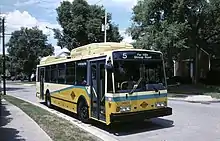Trolleybuses in Dayton
The Dayton trolleybus system forms part of the public transportation network serving Dayton, in the state of Ohio, United States. Opened on April 23, 1933,[1][2] it presently comprises seven lines, and is operated by the Greater Dayton Regional Transit Authority, with a fleet of 54 trolleybuses.[2]
| Dayton trolleybus system | |
|---|---|
 | |
| Operation | |
| Locale | Dayton, Ohio, United States |
| Open | April 23, 1933 |
| Operator(s) | 1933–72: Various private companies (see table in article); 1972–present: Greater Dayton Regional Transit Authority |
| Infrastructure | |
| Electrification | 600 V DC |
| Website | Greater Dayton RTA |
One of only five such systems currently operating in the U.S.,[3] and the only one in a city without a subway, light rail, or streetcar system, the Dayton trolley bus system is the current manifestation of an electric transit service that has been operated continuously in Dayton since 1888 — longer than in any other city in the United States. By the 1970s, Dayton was already the smallest U.S. city still operating a trolley bus system.[1] For both of these reasons, the city's trolley buses are locally considered an icon of Dayton.[4]
History
The first electric trolley bus (ETB) service in Ohio began operation in Dayton, on April 23, 1933, when the Salem Avenue-Lorain Avenue line was converted from streetcars to trolley coaches — or trolley buses, as they are most commonly known today. Electric streetcar service in Dayton had started in 1888, and it continued through to, and indeed beyond, the start of trolley bus service. The last streetcar line in Dayton, City Railway's route 1-Third Street, was converted to trolley buses on September 28, 1947.[1][5] Today, and already the case by the 1980s,[5] Dayton's trolley bus system is the second-oldest in the Western Hemisphere[5][6] (which in 2011 totals 18 systems[3]), exceeded in longevity only by the Philadelphia trolley bus system, which opened on October 14, 1923.[5][6]

The first trolley bus line in Dayton was opened by the Dayton Street Railway company (DSR). The impetus for the decision to adopt trolley buses was a 1932 fire at the company's carbarn (maintenance and storage facility), which gutted the building and destroyed 16 streetcars and two gas buses.[1] After studying trolley coach systems then operating in other small cities, DSR placed an order with the J. G. Brill Company for 12 trolley buses, and these inaugurated service on the city's first ETB line in April 1933. However, the Dayton Street Railway was only the first of several companies to operate trolley bus service in Dayton, some of which operated concurrently and shared overhead wires on some sections, mainly in downtown.[5]
In the late 19th century, it was common in the United States for cities to be served by multiple different streetcar companies, each company typically operating a few lines.[1][5] However, via mergers, acquisitions and sometimes bankruptcy the number of operating companies gradually declined to just one or two in each city. By 1930, most U.S. cities had just one company providing all urban transit service. Dayton was unusual in having multiple transit companies in operation through to the World War II era.[1][5] In 1933, when the first trolley bus service began operating, Dayton still had five separate streetcar companies providing urban service, and all five eventually converted some or all of their routes to trolley buses, over the period 1933–40; these are the first five companies listed in the table below.[5] As late as the 1960s, transit service in Dayton was provided "almost exclusively by trolley coaches".[1]
The table below lists all of Dayton's trolley bus operators since the introduction of the mode in 1933.[1][5]
| Name | From | To | Notes |
|---|---|---|---|
| Dayton Street Railway Company | April 23, 1933 | April 28, 1941 | Renamed Dayton Street Transit Co. circa 1935.[5] Acquired by City Railway Company in 1941. |
| Oakwood Street Railway Co. (OSR) | January 19, 1936 | October 1, 1956 | Acquired by City Railway Company. |
| Peoples Railway Co. (PR) | October 11, 1936 | March 9, 1945 | Acquired by City Railway Company. |
| City Railway Co. (CR) | March 25, 1938 | October 31, 1955 | Merged with Dayton-Xenia Railway Co. to form City Transit Company. |
| Dayton-Xenia Railway Co. (DXR) | October 1, 1940 | October 31, 1955 | The last newly built system to open. Merged with City Railway Co. to form City Transit Company. |
| City Transit Company (CT) | November 1, 1955 | November 4, 1972 | Formed by merger of CR with DXR, not new construction. Taken over in 1972 by new public authority, the Miami Valley Regional Transit Authority. |
| Miami Valley Regional Transit Authority (now Greater Dayton RTA) | November 5, 1972 | present | Current operator of the system, renamed from MVRTA to GDRTA in 2002. |
For a period of about seven months starting in October 1940, Dayton had five independently owned and operated trolley bus systems,[1] and it was the only city in the world ever to possess that many independent trolley bus systems concurrently.[5]
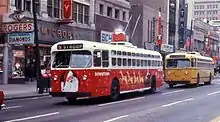
After 1955, all public transit in Dayton was operated by the City Transit Company. The transit system was transferred from private to public ownership on November 5, 1972, when the newly formed (in 1971) Miami Valley Regional Transit Authority (MVRTA) took over the City Transit Company's system.[1] MVRTA changed its name to the Greater Dayton Regional Transit Authority (GDRTA) around May 2002.[7] The name is commonly shortened simply to RTA.
The RTA voted to continue trolley bus operation, and in the mid-1970s replaced the aging fleet of Marmon-Herrington trolley buses with 64 Flyer E800 units, delivered in 1977.[8]
In the late 1980s, the Dayton trolley bus system was headed towards closure. The RTA Board of Trustees voted in 1988 to phase out trolley bus operation, but this decision was reversed in 1991, after a consultant's study report indicated that retaining trolley bus service was the most cost-effective option over the long term,[9][10] as well as having environmental benefits.[11] Following this decision, RTA began refurbishing some of its Flyer trolley buses, to ensure they would continue to operate reliably until a fleet of new trolley buses could be purchased and put into service, in a few years' time.[10]
Over the period 1996–99, the Flyer E800s were replaced by a new fleet of 57 vehicles built by Electric Transit, Inc. (ETI), based on an existing model of the Czech company Skoda (and partially built by Skoda), with final assembly taking place in Dayton.[9] ETI was a joint venture owned 65% by Skoda and 35% by the U.S. company, AAI Corporation.[9]
Current routes
Trolley buses currently operate on seven RTA routes. Since 1988, it has been the same seven routes, but with some changes made to the routings or service levels. These are routes:
- 1 East Third Street / West Third Street
- 2 Lexington / East 5th Street
- 3 Wayne Avenue
- 4 Hoover / Xenia-Linden
- 5 Valley Street / Far Hills
- 7 North Main / Watervliet
- 8 Salem / Lakeview.
(A slash indicates a route that runs in two different directions from downtown Dayton; such routes are sometimes referred to as two routes, e.g. as 1E and 1W,[8] or as "5-north" and "5-south".[12]) Trolley buses normally provide all of the service on routes 4, 5, 7, and 8, except when service is temporarily disrupted by major road construction, but routes 1, 2, and 3 use trolleys only on a few trips in the weekday rush hour and are otherwise served by diesel or hybrid buses. Following a systemwide RTA service restructuring implemented in January 2007, route 5 has only one round trip in each peak period, most of its previous service having been taken over by a parallel diesel bus route.[12]
Fleet
Past fleet
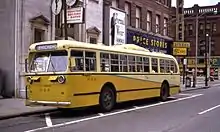
Dayton's first trolley buses were supplied by the J. G. Brill Company, in 1933. Vehicles purchased later included additional Brills, along with ETBs built by Pullman-Standard and Marmon-Herrington. Most of these were newly built vehicles, but between 1956 and 1965 the City Transit Company made several purchases of used trolley buses from other cities, acquiring 21 Brills from Little Rock, Arkansas, and Indianapolis, Indiana; and 75 Marmon-Herringtons from four cities: Little Rock; Cincinnati, Ohio; Columbus, Ohio and Kansas City, Missouri.[13] By the end of the 1960s, the system's last Brill trolley buses had been retired, as had most of the Pullmans, but a few of latter remained in use into the period of RTA ownership, being stored in 1973 and eventually scrapped.[13] Marmon-Herrington trolley buses thereby comprised almost the entire fleet at the time of transfer of the system to public ownership in 1972.
A notable purchase of a single trolley bus occurred in 1971, when the City Transit Company purchased a model E700A trolley bus from Western Flyer Coach (now known as New Flyer Industries).[8][13] It was the first new trolley coach purchased by any U.S. transit system since 1955.[14] Numbered 900, its electric motors and control equipment were taken from two of CT's retired Brill trolley buses, but all else was new, and the vehicle was widely considered to be a new trolley bus.[1] The MVRTA was formed in 1971, and in late 1972 purchased the entire City Transit system, including its fleet of vehicles. In 1974, Flyer discontinued its model E700, replacing it with model E800.[15]
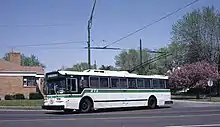
MVRTA placed an order for 64 Flyer E800 trolley buses in January 1975. The first two were delivered in late 1976 and the remainder in 1977. They were the city's first air-conditioned trolley buses. Wheelchair lifts were retrofitted to them in 1983.[13] The last Marmon-Herrington trolley buses were withdrawn from service in October 1982.[13] Flyer trolley buses then comprised the entire fleet (for normal service) until the mid-1990s. RTA acquired two 1981–82 Brown-Boveri-built, GM "New Look"-body trolley buses from the Edmonton Transit System, in Canada, in 1995,[16] retrofitted wheelchair lifts to them, and placed them in service in 1996.
Anticipating retiring its 1976–77 Flyers at about 20 years of age, RTA began considering options for purchasing new vehicles, and in 1994 the agency placed an order with Electric Transit, Inc. for 63 new trolley buses.[8][17][18] The order was later reduced to 61 vehicles,[19] and ultimately to 57.[20] Between 1996 and 1999, these replaced all of the Flyer buses. The two ex-Edmonton vehicles, which were not air-conditioned, were both withdrawn from service by mid-2002.
ETI
Dayton's first ETI trolley buses were three prototypes built in 1995 and delivered to RTA in late December 1995 and January 1996.[20] Numbered 9601–9603 in RTA's fleet, they were model 14TrE. The E in the model number is a suffix standing for "export", because the 14TrE model was Skoda's first 14Tr model designed for the North American market, which market had requirements that had not applied in Europe, including that wheelchair lifts be included. At the time (and for many years prior), Skoda was one of the largest manufacturers of trolley buses in the world[8][16] and it had been producing variations of its model 14Tr since 1974, making about 3,350 of that model by 1999.[6]
The suffix E2 denotes the production series of the export model, which incorporated several changes adopted after testing of the three prototypes, in particular relocation of the wheelchair lift from the rear door to the front door and, necessitated by that change, widening of the body.[21] The single-pane windshield was replaced by a two-piece one,[21] and the rear window was made smaller. The length of the 57 ETI vehicles, both models, is 37 feet 8 inches (11.5 m)[21]—slightly shorter than the 40-foot (12 m) standard length for U.S. transit buses.[15] The width was 98.4 inches (2.5 m) for the three prototypes, but was increased to 102 inches (2.6 m) (the standard transit bus width in the U.S.)[15] for the 54 production-series units.[9]
The three 1995 ETI prototypes, Nos. 9601–9603, all entered service in April 1996.[22] The production-series ETIs, the 9800s, began to arrive in January 1998[23] and entered service between May 1998 and September 1999.[24] By about mid-2004, the 9600s were no longer in regular use. They were retired in 2006, because RTA was having trouble obtaining parts for them, given that they were a small batch of a unique model (not used by any other trolley bus system) and had many differences from the production-series vehicles, RTA's 9800s.[25] As of autumn 2013, 35 of the 54 9800-series ETIs were on active status.[26]
With its fleet having reached 15 years of age by that time, RTA began making plans to purchase replacement vehicles, with plans to test new models and a goal of being ready to place an order by 2016, when the fleet will be about 18 years old.[27] After testing four prototype Gillig/Kiepe dual-mode trolleybuses, two equipped with auxiliary diesel engine and two with batteries, RTA placed an order for 41 new trolleybuses with batteries, which were delivered in the course of 2019 and 2020. The last Skoda/ETI trolleybuses were retired in October 2019.
Current fleet
The present Dayton trolley bus fleet comprises two types of trolley buses:
| Fleet numbers | Image | Quantity | Manufacturer | Electrical equipment | Model No. | Configuration | Year built | Notes |
|---|---|---|---|---|---|---|---|---|
| 1401–1404 | 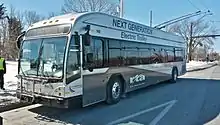 | 4 | Vossloh Kiepe/Gillig[lower-alpha 1] | Vossloh Kiepe | BRTPlus[lower-alpha 2] | Standard (two-axle), low-floor | 2014 | 1402 is out of service due to an accident. |
| 1951–1971 2051–2070 |
41 | 2019-20 |
- Notes
Dual-mode buses
In May 2013, RTA placed an order with Vossloh Kiepe for four prototype low-floor, dual-mode buses,[27] the first of which (No. 1401) arrived on September 29, 2014,[29] and the other three between November 2014 and January 2015. Gillig provided the bus bodies, using its "BRT" model, into which the Vossloh Kiepe propulsion equipment was installed.[27] All four are capable of operating as trolley buses, but for operation away from the trolley wires, two use a diesel-powered generator to power the traction motors (similar to a hybrid bus) and two use batteries only. Vossloh Kiepe referred to the technology as "NexGen", for Next Generation,[28] a branding that RTA has also used when referring to the new vehicles. The prototype buses began to enter service in early 2015, running in both trolley mode and diesel or battery mode, for evaluation. It was planned that after testing, which was expected to last about one year, RTA would choose between the two designs and consider placing an order large enough to replace its entire ETI trolley bus fleet.[27] In 2015, RTA had already included in its budgeting for future years $43 million for an eventual purchase of 41 more Gillig/Vossloh Kiepe dual-mode buses, for delivery by 2019, if testing of the four prototype vehicles showed the design to be reliable and worth the cost.[28] Of the two alternative designs, the one using batteries for operation away from the trolley wires was chosen at the conclusion of testing; they carry RTA fleet numbers 1403 and 1404.
.jpg.webp)
In fall 2016, RTA's Board of Trustees approved moving ahead with an acquisition of at least 26 additional dual-mode buses, once federal officials approved the final design;[30] that approval was received at the beginning of 2018. In January 2018, RTA placed an order with Kiepe – which meanwhile had been sold by Vossloh and renamed Kiepe Electric – for 26 production-series dual-mode buses of the same type as prototypes 1403–1404, with bodies and chassis supplied by Gillig as a subcontractor to Kiepe.[31] The first unit is expected to arrive in spring 2019. The final assembly of all but the first two or three vehicles was originally planned to take place in Dayton,[31] but that plan was later dropped,[32] in exchange for an accelerated production schedule. In November 2018, RTA placed an order with Kiepe for an additional 15 buses of the same type.[32]
In April 2018, prototype No. 1404 was repainted in a new green-and-silver paint scheme which RTA intends to use for the new vehicles on order.[33]
The 41 Gillig-Kiepe trolleybuses were delivered in the course of 2019 and 2020 and replaced the remaining Skoda/ETI trolleybuses.
Preserved trolley buses
Several retired Dayton trolley buses have been saved for historical preservation, including at public museums. Unique 1971 Flyer E700A No. 900 has been preserved by RTA,[6] but is not available for public viewing. 1949 Marmon-Herrington-built trolley bus 515 was kept in operating condition by RTA as a historic vehicle, and between 1984 and 1987 it operated occasional special-event trips on the system; since 1988, it has been on static display at the Carillon Historical Park in southern Dayton. Another Marmon-Herrington No. 501 is kept in storage by RTA. Flyer E800 Nos. 916, 937 and 953, ex-Edmonton BBC HR150G Nos. 109 and 110 and Skoda/ETI Nos. 9602 and 9835 are preserved by RTA, but are not available for public viewing. The Illinois Railway Museum's collection includes ex-Dayton (City Transit) Pullman trolley bus 435, two ex-Dayton Flyer E800s, Nos. 906 and 925 and ex-Dayton Skoda/ETI 9809.[34] Skoda/ETI 9803 was donated and returned to the Czech Republic where it will be on display at the public transport museum in Plzeň. Additional historic ex-Dayton trolley buses have been saved by others.[6]
References
- Sebree, Mac; and Ward, Paul (1974). The Trolley Coach in North America, pp. 91–103. Los Angeles: Interurbans. LCCN 74-20367.
- "Trolleybus city: Dayton (USA)". Trolleymotion. Retrieved May 13, 2014.
- Webb, Mary (ed.) (2010). Jane's Urban Transport Systems 2010-2011, pp. "[23]" and "[24]" (in foreword). Coulsdon, Surrey (UK): Jane's Information Group. ISBN 978-0-7106-2915-9.
- "Dayton icons selected for U.S. collection". Dayton Business Journal. June 5, 2000. Retrieved August 30, 2011.
- DeArmond, Richard C. (March–April 1985). "The Trolleybus System of Dayton, part 1". Trolleybus Magazine No. 140, pp. 32–36. National Trolleybus Association (UK). ISSN 0266-7452.
- Murray, Alan (2000). World Trolleybus Encyclopaedia. Yateley, Hampshire, UK: Trolleybooks. ISBN 0-904235-18-1.
- Trolleybus Magazine (TM) No. 246 (November–December 2002), p. 143.
- Pence, Herb (Summer 1995). "A Generation Behind ... or One Ahead?" (Dayton feature article). The New Electric Railway Journal, pp. 13–18.
- Schultz, Russell E. (2003, No. 4). "System Spotlight: Dayton". Motor Coach Today, pp. 3–8. Motor Bus Society.
- Kunz, Richard R. (Autumn 1992). "Transit's Stepchild Fights Back". The New Electric Railway Journal, pp. 28–29.
- Helgason, Julia (December 4, 1991). "RTA reverses, retains trolleys: Environmental, fiscal concerns sway the vote, 7-2". Dayton Daily News.
- Trolleybus Magazine No. 273 (May–June 2007), p. 70–71.
- DeArmond, Richard C. (May–June 1985). "The Trolleybus System of Dayton, part 2". Trolleybus Magazine No. 141, pp. 49–65.
- Sebree, Mac; and Ward, Paul (1973). Transit's Stepchild: The Trolley Coach, p. 253. Los Angeles: Interurbans. LCCN 73-84356.
- Stauss, Ed (1988). The Bus World Encyclopedia of Buses. Stauss Publications. pp. 7, 62. ISBN 978-0-9619830-0-0.
- Pappas, John (April–June 1995). "Dayton Update". Motor Coach Age, pp. 33–36. ISSN 0739-117X.
- Miami Valley Regional Transit Authority (now GDRTA) (Nov. 1, 1994). “RTA Awards Official Contract for 63 New Electric Trolleybuses.” Press release.
- Bland, Jim (November 2, 1994). "RTA to buy Czech electric buses". Dayton Daily News, p. B5.
- Trolleybus Magazine (TM) No. 206 (March–April 1996), pp. 50–51.
- TM No. 207 (May–June 1996), pp. 82–83.
- Wilkins, Van (Summer 1996). "New Electric Trolley Buses in Dayton". Bus World (ISSN 0162-9689), p. 18.
- Trolleybus Magazine No. 208 (July–August 1996), p. 106.
- Trolleybus Magazine No. 220 (July–August 1998), p. 95.
- Trolleybus Magazine No. 229 (January–February 2000), p. 24.
- Trolleybus Magazine No. 269 (September–October 2006), p. 119.
- Trolleybus Magazine No. 314 (March–April 2014), p. 54.
- Trolleybus Magazine No. 311 (September–October 2013), p. 136.
- Hulsey, Lynn (April 3, 2015). "New battery key to decision; Replacement of RTA fleet could cost as much as $91M". Dayton Daily News. Retrieved November 30, 2015.
- Trolleybus Magazine No. 318 (November–December 2014), p. 164.
- Trolleybus Magazine No. 334 (July–August 2017), p. 157.
- Trolleybus Magazine No. 339 (May–June 2018), p. 117. ISSN 0266-7452.
- Trolleybus Magazine No. 345 (May–June 2019), p. 115, 117. ISSN 0266-7452.
- "Greater Dayton RTA unveils design for electric trolleys". Dayton Business Journal. April 24, 2018. Retrieved June 1, 2019.
- "Roster of Equipment: Trolley Coaches". Illinois Railway Museum. Retrieved August 30, 2011.
External links
![]() Media related to Trolleybuses in Dayton at Wikimedia Commons
Media related to Trolleybuses in Dayton at Wikimedia Commons
- Greater Dayton Regional Transit Authority
- "Trolleybus city: Dayton". Trolleymotion.
- Dayton database / photo gallery and Dayton trolleybus list at Urban Electric Transit – in various languages, including English.
- Older Dayton trolley bus photos advertisements and articles
- More recent photos of the Dayton trolley bus system
